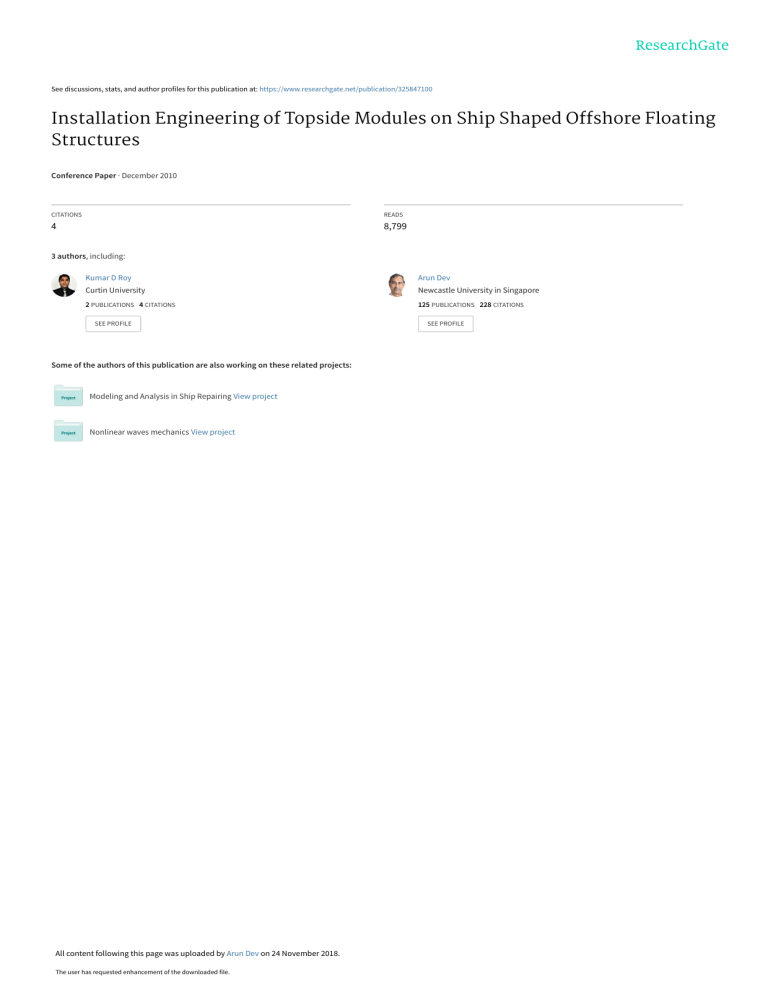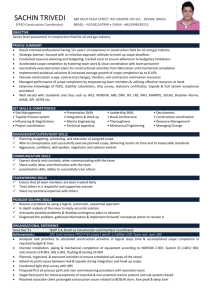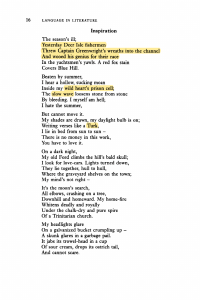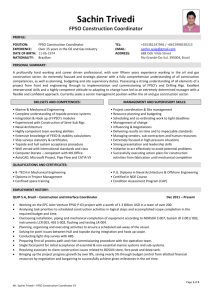
See discussions, stats, and author profiles for this publication at: https://www.researchgate.net/publication/325847100 Installation Engineering of Topside Modules on Ship Shaped Offshore Floating Structures Conference Paper · December 2010 CITATIONS READS 4 8,799 3 authors, including: Kumar D Roy Arun Dev Curtin University Newcastle University in Singapore 2 PUBLICATIONS 4 CITATIONS 125 PUBLICATIONS 228 CITATIONS SEE PROFILE Some of the authors of this publication are also working on these related projects: Modeling and Analysis in Ship Repairing View project Nonlinear waves mechanics View project All content following this page was uploaded by Arun Dev on 24 November 2018. The user has requested enhancement of the downloaded file. SEE PROFILE Proceedings of 4th PAAMES and AMEC2010 Dec. 6-8, 2010, Singapore Installation Engineering of Topside Modules on Ship Shaped Offshore Floating Structures Kumar D Roy 1, Arun Kr Dev 2, Seref Aksu 2 1 MPhil Student, Newcastle University Marine International Singapore 2 Newcastle University Marine International Singapore Abstract In this review paper, the study begins with investigation of governing technical parameters for heavy lifting. This is then followed by installation phase and hull integration covering necessary structural modifications on deck of ship shaped offshore floating structures for the stated purpose. The interrelationships amongst a number of key parameters/aspects of installation process of a topside module such as weight control, heavy lifting and rigging consideration, local FEM analysis of lifting points and members, installation tolerance and design of fine guides are studied. Findings of the study include their contributions to the topside module installation process. Keywords: Topside Module, Module Support, Weight Control, Heavy Lifting, Rigging Analysis, Pad Eye, Trunion, CoG Envelope, Hull Integration, Hull Deflection, Local FEM Analysis, Fine Guiding, Decision Support Diagram Abbreviation: PAU-Preassembled Unit, DAF-Dynamic Amplification Factor, SKF-Skew Load Factor FEA Finite Element Analysis, COG-Centre of Gravity 1 Introduction Several technical considerations and proper interfacing among the parties involved within a time constraint are decisively important for topside module installation engineering on a ship shaped floating structure, like a FPSO/FSO. The aim of this paper is to study the main technical parameters limited to installation and hull integration of topside modules only. The study is carried out on available industry guidelines, technical notes as well as actual projects for identification of technical nature and importance of the keyword parameters. Figure 1 shows a heavy lifting crane carrying a topside module for installation on a floating FPSO hull with a typical 4 point rigging arrangement. 2 Literature review Basic topside layout design considerations like process flow, storage, load effects, etc. and their impact on initial layout are discussed by Chakrabarti et al (2005). Consideration among operational requirements from topside modules with priorities and statutory recommendations are also briefly cited with two practical design layout discussions by the same author. Marshall and Smith (2002) presented a detailed account of FPSO design issues. Issues such as hull deformation of pre-assembled units (PAUs), utilization of deck space, structural production facilities, interface supports arrangement, effects of contractual arrangement for topside fabrication, cross linking of PAUs and other factors are also outlined in Marshall and Smith (2002). Fig.1 Heavy Lift crane with Topside Module The primary functions of the foundation structures (module support structures) and the spaces adjoining them are as follows as mentioned by Paik and 1 Thayamaballi, (2007) originated from a paper by Krekel and Kaminski (2002): Table 1 Dominant Loads and components a. Provide support to the topsides modules on the hull upper deck, b. Provide space for deck piping and hull equipment, c. Provide space for safeguard and utility systems on the hull upper deck, d. Allow for sufficient natural ventilation on the hull upper deck; for example, so as to prevent explosive gaseous mixtures, e. Help in creation of a fire barrier between the topsides and the hull upper deck, f. Help in the creation of a hazardous-area subdivision for equipment (e.g., electrical). For any engineering analysis, it is essential that loads acting on the structure are clearly defined and determined. The main dominant basic loads acting on the main FPSO hull are described in Henriksen et al (2008) and given in Table 1. The foundation effect on topside modules from hull girder deflection is also described in Henriksen et al (2008) and given in Table 2. Dominant Hull Girder Loads Load Components Hull Girder Bending Still Water and Wave Induced Hull Girder Shear Still Water and Wave Induced Differential Pressure on Static and Inertia Transverse Bulkheads Pressure Differential Pressure on Static and Inertia Longitudinal Bulkheads Pressure Dominant Topside Loads Loads Components Module Reaction Loads Static and Dynamic from Hull Deflection and Loads Tank Loads Loads due to FPSO Static and Dynamic Inclination Accelerations Module Mass Distribution and Centre of Gravity Module Location on FPSO, i.e. each module gets unique combination of 6 degree of freedom accelerations and hull girder loads Static and Dynamic Accelerations Static and Dynamic Accelerations Table 2 Foundation and Topside Effect Foundation Effect on Topside Modules from Hull Girder Deflection Relative Deflection Mode Load Origin Longitudinal Still Water and Wave Hull Girder Vertical and Horizontal Bending Vertical Hull Vertical Bending Transverse Transverse Bending Primary Factors Hull Length, Hull Breadth, Block Coefficient, Longitudinal Strength, Topside Installation Height Hull Length, Hull Breadth, Block Coefficient, Longitudinal Strength Transverse Strength, Topside Installation Height, Topside Module Width Topside Module Effect on Hull Relative Deflection Mode Longitudinal Vertical Transverse Load Origin Primary Factors Surge, Pitch, Yaw Inclination Topside Module Mass, Topside Module and Acceleration Centre of Gravity Heave, Pitch, Roll Inclination and Topside Module Mass, Topside Module Acceleration Centre of Gravity, Topside Module Width, Topside Module Length Sway, Roll, Yaw Inclination Topside Module Mass, Topside Module and Acceleration Centre of Gravity 2 Topside weights are generally known when the project enters into the structural design phase. Their distribution on the topside structure is known only after a first design analysis. Moreover, the load distribution among different supports between the hull and the topside also depends on the design engineering of the topside structure. Gourdet (2008) described the important parameters of hull-topside structural assessment as • • • • • • • • 3 Weight Control Weight control procedure is mainly maintained by two basic ways: first by the basic module designer’s weight control guided by basic design parameters and second by the module designer followed by actual fabrication feed back. Module designer’s weight control plan has to cover load cases such as load out, transport, lift, dry installation, normal operating conditions and maximum future operating condition. Topside loads, Hull motions and accelerations from hydrodynamic analysis, Hull girder deformations (Horizontal and Vertical bending moment, torsion), Effects leading to deck stresses concentration, Effects of alternate filling, Poisson effect, Steel dilatation, Effect of attached structures. Further, Gourdet (2008) suggested possible analysis solutions for the structural assessment of the interface structure. These include a. Hull partial models and topside loads (3 hold hull topside force assumed). b. Hull partial models and main structure of topsides (3 hold hull and first main topside structure). c. Complete hull model and main structure of topsides (Full hull and primary topside structure). d. Integrated model (Full hull and topside coupled model). An example to an integrated study discussed by Gourdet (2008) can be given as one that is carried out by Henriksen et al (2008). The authors carried out and presented FE analysis findings based on horizontal and vertical deflections using iterative analysis. Detailed analysis leading to site specific design and on deck installation is not the finishing line for the topsides. Apart from conventional maintenance items like painting deterioration, subsequent corrosion, ageing of material potential water ingress, consideration to be given on fatigue induced responses not only by the sea state during normal operations but also from towing to construction yard. A risk based inspection procedure considering probabilities of evaluation, risk acceptance criteria showing level of probability, consequence and risk can be adopted (Trouchton et al, 2007). Fig. 2 A snapshot of chronographic weight and centre of gravity (CoG) tracking. The module fabricator maintains a weight budget and weight need not to exceed budget. The module fabricator’s weight is based on the contract weight, material take off (MTO) from PDMS (Plant Design Management System) manual, MTO from various disciplines and master equipment list. A standard procedure is to be prepared for weight and centre of gravity tracking information in every phase from design, fabrication to installation on board (see Figure 2). As blocks are fabricated in various locations and in differing capacities, weight tracking then becomes more crucial. 4 Transportation Upon completion of the fabrication of a module, it is transported to the installation yard. From the fabrication ground it is lifted or skidded onto a transportation barge. Skidding is commonly done for load out on a transportation barge. Ground transportation is mostly carried out by trailer type transport systems. 3 A methodical discussion on module transportation and load out is given in guideline documents by Noble Denton (2005). Proper sea fastening, structural load effects due to a particular sea route are key technical considerations for the transportation. Often, specialist contractors are engaged for the task. An operational risk analysis procedure can play an important role in reducing the risk associated with the transportation of the module assemblies. Practical cases of load out and transportation with numerous illustrative examples in different geographic locations and operating environments are discussed by Gerwick (1999). 5 Engineering on Deck Dimensional accuracy in both longitudinal and transverse directions is very critical for both stool bottom to main deck and skid top to topside module. Quite often, the shipyard engages a separate third party dimension measuring contractor for the accuracy. Laser, theodolite or string based dimensional measurement techniques are used to achieve the required dimensional accuracy with very small tolerances. It is important to note that once the topside modules are placed, it is very difficult to make further modifications. The piece and weld map drawing (a drawing that shows all the details of welding throat size for all critical connections) are to be followed. The main load bearing connections has to be verified by non destructive testing (NDT) which is usually carried out by a third party company. The longitudinal and transverse distances need to be as accurate to the design condition as possible (Figure 3). As the volume of upper deck piping is massive, it is expected that they are carried out simultaneously with topside support installation and preferably before the topside module installation. For the safe installation of topside modules, the designer should also consider Dynamic Amplification Factor (DAF), Skew Load Factor (SKF) and sling Minimum Breaking Load (MBL). These are discussed by Chakrabarti (2001). The empirical values are derived from theoretical studies, model tests and actual feedback from operations. Loads in the lifting points, lifting point design, standard clearances, rigging factors and loads due to uncertainty of rigging alignment are also provided in Noble Denton (2006). The design of topside module main beams has a vital impact on the type of lift, specifics of lifting arrangement as well as sling and shackles. 6 Effect on structure The effect of resolved load on each lifting point and its effect on the primary members need to be rechecked for each lifting condition, as the actual fabrication condition may have weight, dimensional or other condition which was not studied at the early design stage. The most vulnerable places are the newly added lifting pad eye installations. These areas are to be studied by a suitable finite element analysis for the adequacy of the structural design. In practice, the pad eye and trunion are to be examined by NDT. An example of such FEA study results of topside module base frame with lifting pad eye for a specific lift condition is shown in Figure 4. This is a basic study to predict the yield behaviour of the primary girders. The equipment loads used for the study are to be authentic and supported by equipment manufacturer’s provided information. The critical areas for verification are • Connection of lifting eye and topside module, • Local buckling of plating around lifting pad eye, • Bending of primary supporting members. Fig.3 Tubular topside module supports. 4 shown in Figure 6, compiled for inshore and static condition from guideline documents by Noble Denton (2006). The flow chart can be used to determine to acceptability of the lifting arrangement. Operational considerations as described in Figure 5 are not considered here. Empirical formulas and numeric values of factors like SKF, DAF and consequence factor are stated in Noble Denton (2006). The flow chart can detect the specific area where it can be recalculated rather than revising the full set of different calculations. Fig. 4 Utilising FEA to check the module Primary structure. 7 Decision support parameters Parameters like selection of heavy lift crane, location of installation, calculating lift hook load, selection of rigging arrangement, selection of shackle and wire are very much interconnected to each other. Figure 5 shows the main decision support parameters for heavy lifting operation. The parameters are production and planning oriented. Change in one parameter affects design, technical, operational and other factors. For example, ‘D’ (distance between lifting points) is the distance on the module to be lifted and is fixed at the installation time. ‘D’ contributes to ‘A’ (distance between crane and vessel), ’G’ (sling angle with pad eye at X direction), ’J’ (independent and combined SWL of ‘A frame’ and fly jib), ‘M’ (rigging arrangement) and ‘H’ (Boom/fly jib angle). The horizontal projected distance between ‘A frame’ and fly jib is to be same as the distance between lifting points. The horizontal projected distance is controlled by the boom angle and vessel to crane distance. In a particular angle the sling reaction on ‘A frame’ and fly jib is to be within maximum allowed load curve provided by the crane operator. Tie down of two slings at X direction also can keep the distance equal. Figure 5 can help project manager and lift engineer to predict the interconnectivity among different lifting parameters and take lifting decision. Figure 7 shows a typical rigging arrangement with all necessary rigging details. For the arrangement shown in the figure, the weighted or calculated weight for the module is 958 tonnes. Addition for the dynamic factor and the weight of rigging wires and shackles increases the hook load to 1026 tonnes. This represents an increase of 68 tonnes from the calculated module weight, approximately 7 % of the calculated module weight. The maximum expected load on all four points on ‘A frame’ and fly jib are also available in Figure 7. The values of T1, T2, T3 and T4 are to be verified against the safe working load of ‘A frame’ and Fly jib. The use of special plate shackle for obtaining a particular pad eye angle is also shown in Figure 7. This angle guides the pad eye design. Tie down wire as shown in Figure 7 is controlled by the actual distance of points on the ‘A frame’ and fly jib of the lifting crane. Tie down slings are vital for keeping the module loads perfectly as vertical as possible in the lifting slings. 8 Effect of Turning For fast and time efficient fabrication, topside modules are sometimes fabricated in a different orientation other than the actual orientation at installation condition which requires overturning. Pad eye is not suitable for overturning operation as the common industry practice on lateral angle of sling and pad eye is maximum 3 degree. This is because of huge bending moment experienced at the pad eye base. A trunion is commonly used for such overturning operation where lifting sling can rotate to the desired direction with minor friction without experiencing bending moment at transverse direction. An example of FEA study results of topside module base frame with trunion for a very conservative overturning moment is shown in Figure 8. It is a local strength analysis to predict the yielding and buckling tendency around the trunion. A standard flowchart for lifting factors and load is 5 Fig.5 Parameters of lifting and their dependence. 6 Fig.6 Flow chart for lifting arrangement. Fig.7 Rigging arrangement with plate shackle 7 Narrow installation gap and lack of rigging space at the sides are commonly faced installation problems. Plate shackle of special type (see Figure 10) is used to resolve the obstacle. Fig.8 Trunion for overturning. A common problem encountered in design for a pad eye is very large size and high thickness of plates although high strength steel is often chosen. The main causes are heavy sling loads, limited number of pad eye for rigging difficulty and limitation of lateral angle of sling with pad eye. Appropriate under deck stiffening immediately below pad eye and horse shoe plate instead of conventional ring plates can be used to counter the problem. The special features and limitation of a pad eye with horse shoe plates (Figure 9) are: • The increase of thickness from bottom to top gives a proper flow of stress from top to base where conventional ring doublers have a sharp thickness increase. • The most loaded part on the top is thicker compared to same thickness for round ring plates. • The main limitation is to achieve a similar sling angle as per the designed pad eye angle. Fig.10 Plate shackle aligned with pad eye. 9 Fine Guiding Tolerance of misalignment for topside modules on module support are very sensitive, misalignment may lead to a condition where a specific connection is overloaded and which was not a designed condition. Most of the lifting operations in shipyards give a better placing accuracy than in purely offshore condition where wave and wind forces can be quite high for static station keeping of the vessel. Factors such as marine traffic movement nearby, wave and wind forces on vessel are compensated by the dynamic positioning system of the crane vessel in shipyard condition. In practical situation one particular side of the module comes earlier than the other side. A structural fine guiding is required to tackle misalignment. Fine guiding can be done with wire string or structural guide plate. Figure 11 shows a U shaped cut plate both in longitudinal and transverse direction. The module on top can easily sit on guide plate slot. Structural guiding works even one particular side or member hits earlier than the other sides. An earlier marking on the offset between ships centerline and skid reference line gives more accurate measurement of very minor misalignment also. After the operation they are verified for dimensional tolerance again so that the exact amount of misalignment is known after the installation is completed. Fig.9 Pad eye with horse shoe plate. 8 11 References Fig.11 Fine guiding with guide plate 10 Conclusions In this paper, technical considerations for the installation of topside modules are studied which can then be further extended to a more detailed and methodical assessment. The following is the summary of the main points. • Decision support diagrams can thus be used for technical assessment of the procedure. • The findings can be applied to rationalize the assumptions made much earlier than actual installation by the hull and module designer as installation is a vital part for the life cycle of the module. • The integration of topside and main hull in terms of ship’s life cycle is subject to more detailed theoretical studies and model testing. • As a future work, a parametric study of lifting arrangement factors can be carried out testing. • New and finer methods of dimensional control and tolerance can be studied. Bai, Y. 2003 Marine Structural Design, Structural Design Principle, Elsevier, pp. 100-102. Chakrabarti, S. K. 2005 Handbook of Offshore Engineering, Volume I & II, Elsevier, pp.1101-1109, 1089-1092 Gourdet, G. 2008 Connection hull-topsides: principles, designs and returns of experience, Bureau Veritas Technical Paper. Gerwick Jr, B. C. and Morris M.D. 1999 Construction of Marine and Offshore Structures, CRC Press, Art 6.3. Henriksen, L. O., Williams, B. D., Wang, X. and Liu, D. 2008 Structural Design and Analysis of FPSO Topside Module Supports, ABS Technical Paper. Krekel, M. H. and Kaminski, M. L. 2002 FPSOs: Design considerations for the structural Interface hull and topsides. Offshore Technology Conference, OTC 13996, Houston. Marshall, R. W. and Smith, S. L. 2002 UKOOA FPSO Design Guidance Notes For UKCS Service, UKOOA. Noble Denton, 2006 Guidelines for Lifting Operations By Floating Crane Vessels, No 27/NDI, Noble Denton Technical Policy Board. Noble Denton, 2005 Guidelines for Marine Transportations, No 030/NDI, Noble Denton Technical Policy Board. Paik, J. K. and Thayamaballi, A. K. 2007 Ship-Shaped Offshore Installation, Cambridge University Press, pp.328-336 Trouchton, M., Rouhan, A. and Goyet, J. 2007 Risk Based Inspection Approach for Topside Structural Components, Offshore Technology Conference 9 View publication stats






